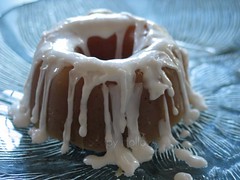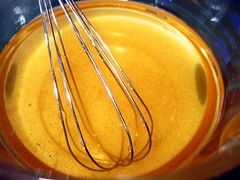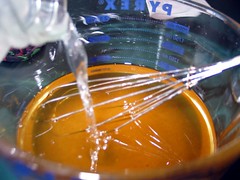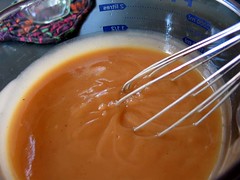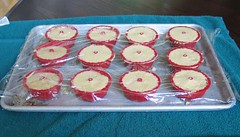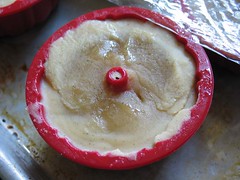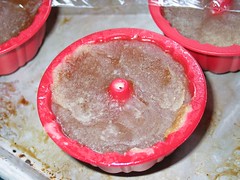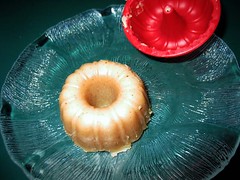How To: Make a small batch of traditional soap
Working with small batches is often trickier than doing the huge batches I often do. But doing small batches lets you get all kinds of creative. Best of all, if you make a mistake, you’re not tossing out hundreds of dollars in materials. It’s fairly easy to “rebatch” a mistake batch when it’s a small batch, where as when you’re staring at 50 pounds of ruined soap…well, let’s just say it gets daunting.
This recipe I designed to fit some groovy little bundt cake molds that I found. Each one holds about 1/4 of cup, and there’s 12 of them. This batch size will also work well in silicon muffin tins, or a small silicon bread pan. (I despise lining boxes, so I use silicon whenever possible.)
Let’s get started!
Ingredients:
- 6 ounces – Coconut Oil
- 6 ounces – Palm Oil
- 1.5 ounce -Castor Oil
- 8 ounces – Olive Pomace
- 3 ounces – Canola
- 3.63 – NaOH (Sodium Hydroxide / Lye)
- 8.5 ounces Water
- 2 tsp Sweet Orange Essential Oil
- 2 tsp Green Tea Essence
- .5 tsp Lemon Essential Oil
- .25 tsp Nutmeg Essential Oil
- .25 tsp Cinnamon Essential Oil
- .5 tsp Clove Bud Essential Oil
- .5 tsp Ground spices consisting of clove, nutmeg, allspice and
cinnamon.
Recommended tools:
- Big Ol’ Pyrex cup
- mason-type jars or glass bowls for NaOH/H2O
- stainless or silicon long handled spoon
- silicon scraper
- stainless steel (or silicon) whisk
- scale (accurate to at least .00 oz)
- candy thermometer
- microwave (not necessary, but easier)
- mold (mould)
- rubber gloves
Please note that for this project, I do not have my faithful assistant, Igor. This is NOT a project for kids. Lye is very dangerous, and children should be kept out of the area where it is being used.
Assemble your ingredients and tools. This batch moves fast after step two, and you don’t want to be running around looking for stuff.
Melt oils in microwave (about 2 minutes on high). Measure out your water into one bowl/jar. Measure your lye in a different, very dry, container.
While your oils are melting, pour NaOH into water.
NEVER EVER NEVER pour water into lye. That would be bad. Crossing the streams bad.
Wearing your rubber gloves, use the long handled spoon to stir the lye and water together into a milky emulsion. Do not breathe the vapors. The lye water will get hot. Quickly. Normally I don’t recommend glass with lye, but mason jars should be more than strong enough for a batch this size, and stainless pitchers are hard to find. However, for safety, I recommend that you do this step at the sink, and let the lye cool in the sink, rather than the counter.
While the lye is cooling, retrieve your now melted oils. If they aren’t melted, stir and nuke in 30 second increments until it’s all liquid. Sprinkle ground spices into warm oils.
Now let everything come to close to room temp, which will take between 30 minutes and 1 hour. You’re shooting for a temp between 80 degrees and 110 degrees F. Take a break, read a book, catch up on email, take over a small country, whatever works for your schedule. Keep in mind that you can always warm the oils, and it doesn’t matter what temp the lye is as long as it’s cooled down below 120F.
Once everything has reached the right temperature range, add the essential oils to the oils and stir. We’re adding the EO at this stage because it’s the processing on a batch this small goes really quickly, and adding the EOs after the lye may cause the batch to seize.
Slowly pour lye into oils while stirring with a whisk.
Whisk emulsion together, stirring until you reach trace, which is the stage where the soap mix is thick enough that the whisk will leave a trace when stirring.
With this batch, trace happens in minutes. Once it’s tracing, but before it gets much more solid, pour into molds. Gently tap molds to release any air bubbles.
Cover molds with cling film. Press along the soap surface to smooth and level your pour. Find a level surface that’s relatively undisturbed.
Place a towel, then the molds, then fold the towel over the molds to completely insulate the soap.
After about 30 minutes, you can see the soap start to “gel”, as the saponification process gets going. Your soaps will feel very warm at this stage.
This is an example of “full gel”, about 1.5 hours after pouring.
Let the molds sit undisturbed and insulated for about a day. When the soap feels solid, you can peel the molds away from the soap, leaving you with this fantastic sweet spiced orange tea bundt cake.
I thought it was missing something, so I added some icing by mixing titanium dioxide with glycerin and poured a drizzle around the cake.
